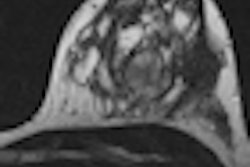Boston researchers have found that successful cryoablation of liver tumors can often be seen with contrast-enhanced MRI as soon as 24 hours after the procedure, allowing physicians to better gauge their results in less time, according to a study published in European Radiology.
The results counter what has been found with radiofrequency ablation of liver tumors, which typically demonstrates no appreciable contrast enhancement on MRI or CT at any point following ablation. The study suggests that the information provided by contrast-enhanced MRI after cryoablation could prevent errors in follow-up treatment strategies.
The lead author of the study is Dr. Paul Shyn from the department of abdominal imaging and intervention at Brigham and Women's Hospital (Eur Rad, February 2012, Vol. 22:2, pp. 398-403).
Seeing the ice ball
Shyn said that cryoablation, which freezes a tumor, is an underutilized technique that can be very helpful in certain cases prior to and during the procedure.
"One of the big advantages of cryoablation is that we can see the 'ice ball' very clearly on CT or MRI; that means we can see exactly what we are ablating during the procedure," he told AuntMinnie.com. "That can be an advantage in terms of getting good results and fully ablating the tumor within the margin, and doing it safely by not freezing or ablating into a critical structure."
Brigham and Women's Hospital typically uses MRI to assess results after 24 hours and at approximately three-month intervals following the procedure. "I noticed that we often see tumor enhancement on the 24-hour MRI that can be quite striking," Shyn said. "Yet we have all been trained that when we think of radiofrequency ablation to expect no [tumor] enhancement within the ablation zone at any time point after ablation."
For this study, Shyn and his colleagues sought patients with no recurrence in follow-up intervals after cryoablation and who had a successful procedure in which the tumor was fully ablated.
A total of 38 patients (24 men and 14 women, with a mean age of 59 years) were enrolled in the study. There were 29 patients with liver metastases and nine with hepatocellular carcinoma. Percutaneous cryoablation of 45 tumors was performed between March 2004 and June 2009, with complete ablation of the tumor and no local recurrence on follow-up MR imaging to date. Tumors ranged in size from 1 cm to 5.6 cm, with a mean of 2.4 cm.
Cryoablation was performed with CT guidance in 25 patients and with MRI guidance in 13 patients. MRI scans were performed on one of several 1.5-tesla or 3-tesla systems (Siemens Healthcare or GE Healthcare). Gadopentetate dimeglumine (Magnevist, Bayer HealthCare Pharmaceuticals) was administered intravenously at 0.1 mmol/kg.
Thirty-seven of the 38 patients underwent preprocedure contrast-enhanced MRI to confirm pretreatment enhancement in 43 of 45 tumors. The 45 tumors were then evaluated with contrast-enhanced MRI approximately 24 hours following cryoablation.
Shyn and colleagues also evaluated 32 tumors with contrast-enhanced MRI between two and four months after cryoablation and 21 tumors between five and seven months following cryoablation.
MR image analysis
The researchers found that 42 (98%) of the 43 tumors exhibited contrast enhancement on MRI prior to the procedure. The mean percentage enhancement of tumors imaged with MRI before ablation was 157%, ranging from 26% to 745%.
Twenty-four hours after cryoablation, 23 (51%) of the 45 tumors showed contrast enhancement on MRI. The enhancing tumors included two (18%) of 11 hepatocellular carcinomas and 21 (62%) of 34 metastases. The mean percentage enhancement of the 23 enhanced tumors was 107%, ranging from 27% to 260%.
Benign enhancement outside of the ablation zone was present in 27 (60%) of the 45 ablation sites.
"With MRI, not only can we see the ablation zone, we can often still see the tumor at 24 hours or later after the cryoablation," Shyn said. "It makes it easier for us to confirm that we have fully ablated the tumor and to see how much of a margin we achieved. That is much harder to do with CT."
The researchers also found that 10 (31%) of the 32 tumors imaged with MR between two and four months after cryoablation demonstrated residual contrast enhancement, with a mean percentage enhancement of 43%, ranging from 24% to 103%.
In addition, six (29%) of the 21 tumors imaged with MR between five and seven months after cryoablation demonstrated residual contrast enhancement. The mean percentage enhancement was 41%, ranging from 26% to 48%.
Aiding interpretation
"The important message was that tumor enhancement at 24 hours -- or even six months after cryoablation -- itself does not indicate a residual viable tumor," Shyn explained. "We think the reason is when we freeze the tissues and tumors during the actual ice ball formation, the blood flow is interrupted completely, but as soon as it thaws, there is reperfusion of blood vessels. Those blood vessels reproduce, but they are damaged."
At 24 hours, the damaged blood vessels are reperfusing themselves and allowing enhancement of the tumor and the liver parenchyma surrounding the tumor that was contained within the ablation zone, Shyn speculated.
While the study's findings have not changed the protocol at Brigham and Women's, it has aided in the interpretation of the contrast-enhanced MR images, Shyn said.
"We now can better define the ablations," he added. "Being able to define the sharp boundary of the ablation zone is very helpful to us in deciding what can be accomplished."



.fFmgij6Hin.png?auto=compress%2Cformat&fit=crop&h=100&q=70&w=100)




.fFmgij6Hin.png?auto=compress%2Cformat&fit=crop&h=167&q=70&w=250)











